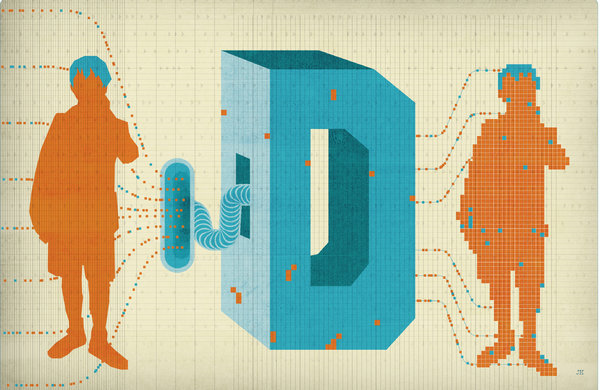



|
|
 By STEVE LOHRPublished: December 29, 2012It was the bold title of a conference this month at the Massachusetts Institute of Technology, and of a widely read article in The Harvard Business Review last October: “Big Data: The Management Revolution.” Andrew McAfee, principal research scientist at the M.I.T. Center for Digital Business, led off the conference by saying that Big Data would be “the next big chapter of our business history.” Next on stage was Erik Brynjolfsson, a professor and director of the M.I.T. center and a co-author of the article with Dr. McAfee. Big Data, said Professor Brynjolfsson, will “replace ideas, paradigms, organizations and ways of thinking about the world.” These drumroll claims rest on the premise that data like Web-browsing trails, sensor signals, GPS tracking, and social network messages will open the door to measuring and monitoring people and machines as never before. And by setting clever computer algorithms loose on the data troves, you can predict behavior of all kinds: shopping, dating and voting, for example. The results, according to technologists and business executives, will be a smarter world, with more efficient companies, better-served consumers and superior decisions guided by data and analysis. I’ve written about what is now being called Big Data a fair bit over the years, and I think it’s a powerful tool and an unstoppable trend. But a year-end column, I thought, might be a time for reflection, questions and qualms about this technology. The quest to draw useful insights from business measurements is nothing new. Big Data is a descendant of Frederick Winslow Taylor’s “scientific management” of more than a century ago. Taylor’s instrument of measurement was the stopwatch, timing and monitoring a worker’s every movement. Taylor and his acolytes used these time-and-motion studies to redesign work for maximum efficiency. The excesses of this approach would become satirical grist for Charlie Chaplin’s “Modern Times.” The enthusiasm for quantitative methods has waxed and waned ever since. Big Data proponents point to the Internet for examples of triumphant data businesses, notably Google. But many of the Big Data techniques of math modeling, predictive algorithms and artificial intelligence software were first widely applied on Wall Street. At the M.I.T. conference, a panel was asked to cite examples of big failures in Big Data. No one could really think of any. Soon after, though, Roberto Rigobon could barely contain himself as he took to the stage. Mr. Rigobon, a professor at M.I.T.’s Sloan School of Management, said that the financial crisis certainly humbled the data hounds. “Hedge funds failed all over the world,” he said. The problem is that a math model, like a metaphor, is a simplification. This type of modeling came out of the sciences, where the behavior of particles in a fluid, for example, is predictable according to the laws of physics. In so many Big Data applications, a math model attaches a crisp number to human behavior, interests and preferences. The peril of that approach[B1] , as in finance, was the subject of a recent book by Emanuel Derman, a former quant at Goldman Sachs and now a professor at Columbia University. Its title is “Models. Behaving. Badly.”
Claudia Perlich, chief scientist at Media6Degrees, an online ad-targeting start-up in New York, puts the problem this way: “You can fool yourself with data like you can’t with anything else. I fear a Big Data bubble.” The bubble that concerns Ms. Perlich is not so much a surge of investment, with new companies forming and then failing in large numbers. That’s capitalism, she says. She is worried about a rush of people calling themselves “data scientists,” doing poor work and giving the field a bad name. Indeed, Big Data does seem to be facing a work-force bottleneck. “We can’t grow the skills fast enough,” says Ms. Perlich, who formerly worked for I.B.M. Watson Labs and is an adjunct professor at the Stern School of Business at New York University. A report last year by the McKinsey Global Institute, the research arm of the consulting firm, projected that the United States needed 140,000 to 190,000 more workers with “deep analytical” expertise and 1.5 million more data-literate managers, whether retrained or hired. Thomas H. Davenport, a visiting professor at the Harvard Business School, is writing a book called “Keeping Up With the Quants” to help managers cope with the Big Data challenge. A major part of managing Big Data projects, he says, is asking the right questions: How do you define the problem? What data do you need? Where does it come from? What are the assumptions behind the model that the data is fed into? How is the model different from reality? Society might be well served if the model makers pondered the ethical dimensions of their work as well as studying the math, according to Rachel Schutt, a senior statistician at Google Research. “Models do not just predict, but they can make things happen,” says Ms. Schutt, who taught a data science course this year at Columbia. “That’s not discussed generally in our field.” Models can create what data scientists call a behavioral loop. A person feeds in data, which is collected by an algorithm that then presents the user with choices, thus steering behavior. Consider Facebook. You put personal data on your Facebook page, and Facebook’s software tracks your clicks and your searches on the site. Then, algorithms sift through that data to present you with “friend” suggestions. Understandably, the increasing use of software that microscopically tracks and monitors online behavior has raised privacy worries. Will Big Data usher in a digital surveillance state, mainly serving corporate interests? Personally, my bigger concern is that the algorithms that are shaping my digital world are too simple-minded, rather than too smart. That was a theme of a book by Eli Pariser, titled “The Filter Bubble: What the Internet Is Hiding From You.” It’s encouraging that thoughtful data scientists like Ms. Perlich and Ms. Schutt recognize the limits and shortcomings of the Big Data technology that they are building. Listening to the data is important, they say, but so is experience and intuition. After all, what is intuition at its best but large amounts of data of all kinds filtered through a human brain rather than a math model? At the M.I.T. conference, Ms. Schutt was asked what makes a good data scientist. Obviously, she replied, the requirements include computer science and math skills, but you also want someone who has a deep, wide-ranging curiosity, is innovative and is guided by experience as well as data. “I don’t worship the machine,” she said. |
|
|
|
||
|
|
|
|
||||||||||||||||||||
|
|
||||||||||||||||||||||
| Site Map |